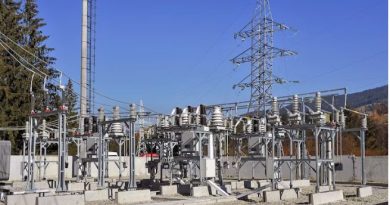ABCD Parameters of Transmission Lines – Theory, Examples and Explanation
ABCD Parameters of Transmission Lines – Theory, Examples and Explanation
Introduction
ABCD parameters represent an important two-port network modeling tool for analyzing transmission line systems. The ABCD matrix relates input and output electrical variables in a linear network through four parameter values. Let’s explore the theory, calculation, transmission line modeling applications, and analysis uses of ABCD parameters.
ABCD parameters, also known as transmission or chain parameters, are a set of four constants used to characterize the behavior of linear electrical networks, particularly in the context of transmission lines. These parameters are vital for analyzing and understanding the transmission of electrical signals through complex networks.
Significance in Transmission Lines
In the realm of transmission lines, ABCD parameters play a critical role. They provide valuable insights into how signals propagate through these lines, helping engineers design and optimize systems for efficient signal transfer. This article will explore the theory, derivation, practical examples, and applications of ABCD parameters in transmission lines.
What are ABCD Parameters?
ABCD parameters are a set of four parameters named A, B, C, and D that characterize a linear two-port electrical network based on its transmission matrix relating the input and output voltage and current quantities in the network. They model the electrical behavior of various networks like transmission lines.
Need for ABCD Parameters
- Analyze transmission line properties like impedance, attenuation, etc., based on line dimensions and electrical parameters.
- Model transmission line sections connected in cascade arrangements.
- Simulate complete transmission medium between source and load using two-port blocks.
- Provide a flexible network analysis tool for circuits, filters, measurements, etc., involving two-port networks.
Two-Port Network Model
ABCD parameters utilize the two-port network model, treating any network as a black box with an input and output port with definable relationships between variables.

Now, let’s examine how ABCD parameters are precisely defined.
Defining ABCD Parameters
Two-Port Network Relations
For a linear two-port network, the input and output variable pairs are related as follows:
V1 = AV2 + BI2
I1 = CV2 + DI2
Where A, B, C, and D are the ABCD parameters.
Parameter Definitions
The parameters represent:
A = output voltage ratio with input shorted
B = output voltage ratio with input open
C = output current ratio with input shorted
D = output current ratio with input open
Physical Meaning
A models attenuation, B models phase shift, C models reflections, and D models interactions between output voltage and current.
Let’s model a transmission line using ABCD parameters.
Transmission Line Model
Equivalent Circuit Model
A distributed network of inductors, capacitors, and resistors can model a transmission line representing the series impedance and shunt admittance.
Relation between Input and Output
For length dx, the infinitesimal input and output voltage and current components are related as:
dVm = (-Zdx)Im + Vm
dIm = (-Ydx)Vm + Im
Characteristic Impedance
The intrinsic line impedance Z0 relates the steady state voltage and current along the line as:
Z0 = sqrt(Z/Y)
Where Z is the series impedance/length, and Y is shunt admittance/length.
Now, let’s calculate the ABCD matrix for transmission lines.
Solving for Line ABCD Parameters
Short Line Parameters
For electrically short lines, the ABCD matrix is approximated as:
A = 1 B = Z0
C = 0 D = 1
Where Z0 is the characteristic impedance.
Medium Line Parameters
For medium lines, the matrix incorporates the propagation constant and line length as:
A = cosh(γl) B = Z0sinh(γl) C = sinh(γl)/Z0 D = cosh(γl)
γ = propagation constant
Long Line Parameters
For very long lines, the hyperbolic functions approximate to exponentials:
A ≈ 0 B = Z0e-γl C = eγl/Z0 D ≈ 0
This models an ideal lossless line.
The ABCD model facilitates transmission line analysis:
Analyzing Transmission Line Performance
Characteristic Impedance
Z0 = sqrt(B/C) = sqrt(Z/Y)
Attenuation Constant
α = Real{γ} = -ln(|A|)/l
Models conductor and dielectric losses.
Phase Constant
β = Imag{γ} = atan(B/A)/l
Determines phase shift between voltage/current.
Propagation Constant
γ = α + jβ
Relates attenuation and phase properties.
Cascaded networks can also be easily modeled:
ABCD Parameters for Cascaded Networks
Cascaded Sections
Transmission systems comprise cascaded segments with intermediate loads.
Applying ABCD Matrix Multiplication
The resultant ABCD matrix is obtained by simply multiplying individual section matrices sequentially.
ABCD parameters can be interconverted to other two-port network parameters:
Conversion to Other Parameters
Conversion to Impedance Parameters
[Z] = inv([A][-B; -C][D])
Where Z11 = Z22 = (A+D)/(AD-BC)
And Z12 = Z21 = (-B)/(AD-BC)
Conversion to Admittance Parameters
[Y] = inv([-B][A; -D][-C])
Where Y11 = Y22 = (A+D)/(AD-BC)
And Y12 = Y21 = (-C)/(AD-BC)
Conversion to Hybrid Parameters
h11 = A/D; h12 = B/D h21 = C/D; h22 = D/D
This flexibility aids analysis for varied network applications.
Key advantages of ABCD parameters:
Advantages of ABCD Parameters
- Model distributed parameter networks like transmission lines based on dimensions and electrical properties.
- Permit analysis of cascaded multi-section network combinations through matrix multiplications.
- Allow flexibility to convert between different two-port network parameters.
- Comprehensive modeling capabilities for simulation, synthesis, and characterization.
ABCD parameters have some limitations:
Limitations of ABCD Parameters
- Do not directly provide insight into network behavior and characteristics.
- The physical interpretation is less intuitive than other parameter sets like impedance parameters.
- It is difficult to measure ABCD parameters directly, unlike scattering (S) parameters.
- Limited characterization accuracy for complex network behavior compared to nonlinear modeling.
ABCD parameters find uses in various analyses:
Applications Using ABCD Parameters
- Modeling transmission line characteristics like attenuation, distortion, reflections, etc.
- Simulation of power transmission and communication networks with cascaded lines.
- Network analysis and synthesis for design problems involving two-port networks.
- Modeling components like transformers, amplifiers, and filters as two-port blocks.
- Characterization of two-port measurements and standards for calibration.
Practical Examples
Example 1: ABCD Parameters in Coaxial Cable
A practical example involving a coaxial cable will illustrate how ABCD parameters are determined and utilized. This example will shed light on real-world applications.
Example 2: Transmission Line with Loads
Another example will explore how ABCD parameters change when transmission lines are connected to different loads. This will highlight the flexibility of ABCD parameters in handling varying network configurations.
Summary
ABCD parameters present a valuable modeling tool for studying linear two-port electrical networks based on the transmission matrix relating to input and output variables. Transmission line analysis represents a key application. While ABCD parameters do not provide direct physical insights, they enable thorough modeling of cascaded networks and flexible interconversion to other parameter sets for broader system characterization and design.
FAQs
- What do the individual ABCD parameters physically signify?
A represents attenuation, B models phase shift, C represents reflection coefficient, and D characterizes output current dependence on voltage.
- What are the main advantages of ABCD parameters?
Key advantages include modeling distributed parameter networks, analyzing cascaded networks through matrix multiplications, and having the flexibility to interconvert between parameters.
- How are ABCD parameters applied for modeling transmission lines?
ABCD matrices can characterize transmission line properties like impedance and propagation constant in terms of physical dimensions and electrical parameters.
- How do ABCD parameters help analyze cascaded networks?
Cascaded networks can be modeled through sequential ABCD matrix multiplications of individual sections.
- How can ABCD parameters be converted to other parameter sets?
Mathematical transformations exist to convert between ABCD parameters and impedance, admittance, or hybrid parameter sets.
- What are some limitations of ABCD parameters?
Limitations include a lack of direct physical insights, a less intuitive nature than impedance parameters, and measurement challenges.
- Where are ABCD parameters most commonly applied?
Major applications include transmission line modeling, network analysis and synthesis, filter characterization, measurements, and telecommunication systems.
- Can ABCD parameters model nonlinear networks?
ABCD parameters can only characterize linear time-invariant networks under specific biasing conditions.
- Are ABCD parameters only applicable to two-port networks?
Yes, ABCD parameter theory is defined explicitly for linear bilateral two-port networks. Multi-port networks require other modeling approaches.
- Can ABCD parameters be directly measured?
No, ABCD parameters cannot be directly measured, unlike scattering parameters. They are determined analytically from network configurations.




